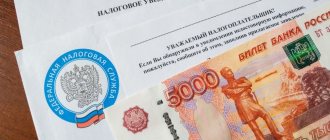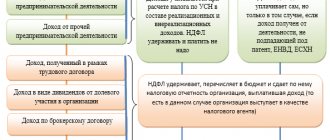Sales of goods, performance of work, provision of services
When selling goods, works or services, the VAT base is revenue, that is, the value under the contract taking into account excise taxes (if any) and excluding VAT (clause 1 of Article 154 of the Tax Code of the Russian Federation). The same rules apply to gratuitous and barter transactions.
It is generally accepted that the contract sets prices that correspond to market prices. Sometimes the tax office checks transactions and charges additional taxes if it finds irregularities in prices.
Example . In January 2021, Lobster LLC shipped a batch of finished products to the buyer, subject to VAT at a rate of 20%. The cost of the batch is 50,000 rubles. The price under the contract and the tax base for VAT is 100,000 rubles (VAT not included). The amount of VAT is 20,000 rubles.
In accounting you need to reflect the implementation as follows:
| Wiring | Sum | The essence of the operation |
| Dt 62 Kt 90-1 | 120 000 | Revenues from sales |
| Dt 90-3 Kt 68 | 20 000 | VAT charged on revenue |
| Dt 90-2 Kt 43 | 80 000 | The cost of finished products sold is written off |
The moment of determining the tax base, also known as the date of VAT calculation, is the date of shipment, completion of work, provision of services and/or day of payment. Depends on what happened before. If you received an advance payment, then the base must be determined twice.
How to determine the shipment date
- in the standard case - the date of the first goods or delivery note drawn up in the name of the buyer or carrier;
- shipment in parts - the date of the invoice drawn up when the last part was shipped;
- the goods are not shipped - date of transfer of ownership;
- sale of real estate - the day of transfer to the buyer according to the deed, etc.
How to determine the date of service provision
- in the standard case - the date on which you signed the certificate of services rendered;
- continuing services - the last day of the month or quarter in which the services were provided.
How to determine the date of completion of work
- in the standard case, the date on which the customer signed the work acceptance certificate.
How is the tax base for calculating VAT determined?
Remember Shakespeare's Hamlet and his famous phrase: “To be or not to be”? An accountant, when determining the tax base for calculating VAT, is often similar to this literary hero.
Only the question sounds different: “To include or not to include the amount of the transaction in the tax base”? But unlike Hamlet, the accountant has the Tax Code, in which answers to questions can be found. Unfortunately, most often these responses are encrypted.
Let's figure out the VAT tax base together: what, when, in what amount.
The content of the article:
1. Object of VAT taxation
2. Moment of VAT calculation
3. Tax base for VAT on sales of goods
4. The moment of determining the tax base upon shipment without transfer of ownership
5. Transfer of ownership without shipment
6. Tax base for VAT for the implementation of works and services
7. Determination of the tax base for VAT upon receipt of full or partial prepayment
8. Determination of the tax base upon receipt of an advance payment by a commission agent or agent
9. Tax base for VAT when importing goods
10. Tax base for VAT and income tax
11. Tax base for calculating VAT: calculation example
12. Example of a tax base in a VAT return
So, let's go in order. If you don't have time to read a long article, watch the short video below, from which you will learn all the most important things about the topic of the article.
(if the video is not clear, there is a gear at the bottom of the video, click it and select 720p Quality)
We will discuss the topic further in the article in more detail than in the video.
Object of VAT taxation
You need to understand that the object of VAT taxation is not yet the tax base for calculating VAT, but just one of the factors that is involved in its determination.
The object of VAT taxation is business transactions, the value of which, under certain conditions, will or will not be included in the taxable base.
What transactions are subject to VAT ? All of them are listed in paragraph 1 of Article 146 of the Tax Code:
- sale of goods (works, services), receipt of advance payment is also an object of taxation
- transfer of property rights
- transfer of goods (works, services) under an agreement to provide compensation or novation
- sale of collateral
- transfer of goods, works, services for one’s own needs, if expenses for such goods (works, services) are not deductible for income tax.
- construction and installation work for own consumption
- import of goods into the territory of the Russian Federation and other territories that are under the jurisdiction of the Russian Federation.
The location of the operation should be the Russian Federation . What is meant by this and what is not is written in detail in Articles 147 and 148 of the Tax Code.
Clause 2 of Article 146 lists those business transactions that are not subject to VAT taxation. If you are convinced that a business transaction is not subject to taxation, then its value does not need to be included in the VAT tax base.
Moment of VAT calculation
When it has become clear that the operation being carried out is subject to VAT taxation, it is necessary to take into account such a factor as the moment the tax is calculated . This means understanding: the tax base for calculating VAT will include the total value of the transaction in this particular reporting period (quarter) or in the next.
The Tax Code, in Article 167, provides for different aspects of determining the tax base for different operations.
The subtleties of determining the moment of VAT calculation, which relate to the sale of goods, works, and services, will be discussed in the relevant sections.
Tax base for VAT on sales of goods
Business transactions that are associated with the sale of products or goods, as already written above, are objects of VAT taxation.
the cost of goods must be included in the tax base . If goods are subject to excise taxes, the cost is counted along with them. In other words, the taxable base for VAT is the proceeds from the sale of goods.
Do not forget that gratuitous transfer is equivalent to sale from a VAT point of view.
An important factor in determining the VAT tax base for the sale of goods is the moment the tax is calculated . This is where you can make a mistake and include revenue in the tax base for the wrong tax period.
If the contract involves the transfer of ownership on the seller’s territory , at the time of shipment, then everything is clear: revenue is reflected in accounting immediately, on the day of shipment, and VAT is immediately charged.
Postings:
| Debit | Credit | Operation |
| 62 | 90, subaccount “Revenue” | Revenue from the sale of goods and finished products including VAT is reflected |
| 90, subaccount “VAT” | 68, subaccount “VAT” | VAT is charged on goods sold and finished products |
| 90, subaccount “Cost of goods sold” | 41 (43) | The cost of goods and finished products at the time of shipment is written off |
The moment of determining the tax base upon shipment without transfer of ownership
When the contract provides for a deferred transfer of ownership : shipment on one day, and recognition of revenue on another day, later, when the buyer receives the goods or the goods are transferred to the carrier, then in this case:
- on the day of shipment, VAT is calculated for payment to the budget
- on the day when the transfer of ownership occurs, revenue is reflected in accounting, VAT payable to the budget is not re-accrued
For example , the shipment of goods occurred in March, and the transfer of ownership took place in April.
Postings in March
| Debit | Credit | Operation |
| 76, subaccount “VAT calculations” | 68, subaccount “VAT” | VAT is charged on goods sold and finished products |
| 45 | 41 (43) | Goods and finished products written off from the warehouse |
Postings in April
| Debit | Credit | Operation |
| 62 | 90, subaccount “Revenue” | Revenue from the sale of goods and finished products including VAT is reflected |
| 90, subaccount “VAT” | 76, subaccount “VAT calculations” | VAT is reflected on goods sold and finished products |
| 90, subaccount “Cost of goods sold” | 45 | The cost of goods, finished products, shipped earlier has been written off |
If you do not make a VAT entry in March, the tax amount for this transaction will not be included in the tax return for the first quarter.
Transfer of ownership without shipment
In practice, a situation often occurs when the goods are sold, ownership has transferred, but the goods are not shipped.
In this case, you need to be guided by clause 3 of Article 167 of the Tax Code. According to this paragraph, the day of transfer of ownership is equated to the moment of determining and including revenue from such transactions in the VAT tax base.
For example , according to the terms of the contract, in March the sale of goods takes place and the transfer of ownership from the seller to the buyer. After which the seller accepts the goods for safekeeping. In April, the goods are physically shipped to the buyer.
Postings in March
| Debit | Credit | Operation |
| 62 | 90, subaccount “Revenue” | Revenue from the sale of goods and finished products including VAT is reflected |
| 90, subaccount “VAT” | 68, subaccount “VAT” | VAT is charged on goods sold and finished products |
| 90, subaccount “Cost of goods sold” | 41 (43) | The cost of goods and finished products has been written off |
| 002 | Sold goods are accepted for storage |
In March, proceeds from the sale of goods must be included in the VAT tax base for the first quarter.
Postings in April
| Debit | Credit | Operation |
| 002 | Shipment of goods, finished products from storage |
Tax base for VAT for the implementation of works and services
The object of VAT taxation is operations for the sale of works and services. As with goods, according to Article 154 of the Tax Code, the tax base includes the valuation of such transactions, that is, revenue.
Unlike the sale of goods, the moment of sale of work and services is the date of signing the act by the buyer .
This is due to the fact that the fact of transfer of work or service can only be confirmed by the fact that the buyer accepted it.
What is acceptance of work is written in Art. 720 of the Civil Code of the Russian Federation: “the customer is obliged” to accept the work “in the time frame and in the manner prescribed by the contract.” This means that the contract establishes the procedure, including a document that must be signed upon completion of the work.
For example , the contractor completed the repair on March 28, according to the contract, the work acceptance period is 5 days. The customer accepted the work on April 1. Therefore, the day of transfer of work will be considered April 1, which means that the cost of work falls into the tax base of the second quarter.
When implementing work (services), there are exceptions when the date of transfer of work is confirmed not by the date of signing the act of completed work by the customer, but by other means.
Thus, when selling electricity, water and other services, the volume of which is determined by metering devices (and this is stated in the contract), the fact of provision of services is confirmed precisely by meter readings. In such a situation, the day of inclusion in the tax base will be the day the readings are taken.
For example , an organization that sells cold water took meter readings from its consumers on March 31 and drew up a report of work performed. The act was received by the organization - the consumer only arrived on April 2, and was signed on April 3. Despite this, revenue from the sale of cold water is included in the VAT tax base for the first quarter.
The moment of transfer of transport services is also determined when the customer’s representative signs the waybill. Revenue must be included in the tax base for the quarter that corresponds to the date of signing the waybill.
Determination of the tax base for VAT upon receipt of full or partial prepayment
If the seller organization works on an advance payment basis, then the amount of the advance payment must be included in the tax base . This is directly stated in paragraph 2 of Article 154 of the Tax Code. We have already talked about this in detail in one of the previous articles, but here we will briefly repeat it again.
If you receive money on account of the future shipment of goods or the performance of work or services, you must include this amount in the tax base of the quarter in which the payment took place (Article 167 of the Tax Code).
This is reflected in accounting as follows:
| Debit | Credit | Operation |
| 51 | 62 | Advance payment received |
| 76 | 68, subaccount “VAT” | VAT is charged on the prepayment received |
There is no need to include in the tax base prepayments for such goods, works, services that:
- not subject to VAT (for example, according to Article 149 of the Tax Code)
- are taxed at a VAT rate of 0%
- are manufactured over six months, and this is due precisely to the technological process
After the sale of the prepaid goods takes place, VAT is charged a second time, in the usual manner:
| Debit | Credit | Operation |
| 62 | 90, subaccount “Revenue” | Revenue from the sale of goods and finished products including VAT is reflected |
| 90, subaccount “VAT” | 68, subaccount “VAT” | VAT is charged on goods sold and finished products |
But there is no need to pay VAT twice .
In the VAT return, the “second” charge must be reflected in section 3, in the part “Taxable objects”. And previously paid VAT on advances is in the same section 3, in the “Deductions” part.
Determination of the tax base when receiving an advance payment by a commission agent or agent
When a product is sold under a commission agreement or an agency agreement, the moment when the taxable base is determined is the day when partial or full prepayment was received into the account of the principal (agent) . This is precisely the point of view that the tax authorities adhere to, which is confirmed by the letter of the Federal Tax Service dated February 28, 2006 No. MM-6-03/ [email protected]
On the issue of the moment of determining the taxable base for VAT to the seller who transfers the goods to the principal (agent), there was another point of view.
Thus, the FAS NWO, by its Resolution dated December 13, 2006 in case No. F04-8319/2006 (29331-A27-42), sided with the taxpayer. And it established that if the principal does not have information about when the proceeds were received by the commission agent, then he cannot take it into account in the tax base. And this is not a violation of the Tax Code.
But later the arbitration courts changed their point of view . It began to coincide with the opinion of the Federal Tax Service.
Thus, in paragraph 16 of the Plenum of the Supreme Arbitration Court dated May 30, 2014 No. 33, the final decision was made that the principal (principal) must determine the taxable base on the basis of Article 167 of the Tax Code. At the same time, he needs to organize the timely receipt of documents from the commission agent (agent).
Tax base for VAT when importing goods
This issue is regulated by Articles 151 and 160 of the Tax Code. The tax base for VAT when importing goods is determined by the formula:
The tax base must be determined for each group of goods of the same name, type and brand. Read more about the calculation of VAT when importing goods in a separate thematic article.
Tax base of VAT and income tax
At first glance, the tax bases of VAT and income tax are similar. In both cases, the main share of the tax base is revenue from the sale of goods, works, and services.
This is the only thing that makes taxes similar; in fact, VAT and income tax have more differences than similarities.
| Characteristic | VAT | Income tax |
| Taxable period | quarter | year (reporting period - quarter) |
| Object of taxation | It was written in detail above | Income minus expenses |
| What is included in the tax base when selling goods (works, services) | Proceeds from the sale of goods (work, services), property rights Cost of goods (work, services) transferred free of charge | Revenue from the sale of goods (work, services), property rights Non-operating income (Article 250 of the Tax Code) in terms of income from leasing property |
| Document | Invoice | The primary document that is drawn up during a business transaction (for example, an invoice, a certificate of completion of work) |
| Moment of determining the tax base | Earlier date:
| The date of transfer of ownership has nothing to do with payment |
Tax base for calculating VAT: example of calculation
In addition to such factors as object, place and moment, which determine the rules for calculating the tax base for VAT, there is also the VAT rate.
When operations carried out are subject to different VAT rates , they must immediately be included in different tax bases (paragraph 4, paragraph 1, article 153 of the Tax Code).
This is important for completing your tax return.
Example
Motylek LLC sells food products, some of them are subject to VAT at a rate of 10% (flour and sugar), some at a rate of 18% (chocolate candies, marshmallows).
Business transactions that were carried out in the accounting of Motylek LLC in the first quarter of 2021:
| Operation | Qty | price, rub. | Cost, excluding VAT, rub. | VAT (rate/amount, rub) |
| Sales of sugar | 100 t | 40 000 | 4 000 000 | 10% / 400 000 |
| Sales of flour | 50 t | 20 000 | 1 000 000 | 10% / 100 000 |
| Sale of chocolates, the date of shipment coincides with the date of transfer of ownership | 10 t | 200 000 | 2 000 000 | 18% / 360 000 |
| Advance payment received for sugar supply in April | 50 t | 40 000 | 2 200 000 | 10%/110% / 200 000 |
| The candies have been shipped to the buyer, the transfer of ownership will occur in April 2017 | 20 t | 150 000 | 3 000 000 | 18% / 540 000 |
Total:
— tax base at a rate of 18% — 5,000,000 rubles
— tax base at a rate of 10% — 5,000,000 rubles
— prepayment, which includes VAT at a rate of 10% - 2,200,000 rubles.
Example of a tax base in a VAT return
An example of the tax base in the VAT return was compiled based on the operations of Motylek LLC for the first quarter.
Let's sum it up. To know what tax base you have for calculating VAT, it is important to establish:
- Is the transaction subject to taxation?
- Is the operation being carried out on the territory of the Russian Federation or not?
- At what point should a business transaction be included in the tax base?
- cost estimate of the operation
If you answer these questions, you will not make mistakes, draw up the declaration correctly and pay VAT to the budget in the required amount.
The article examined the most typical situations.
Is there anything left unclear? Do you have a “difficult case”? Ask in the comments: we will answer, we will help.
How is the tax base for calculating VAT determined?
Receiving an advance
Include in the database the entire amount of the prepayment, including VAT (clause 1 of Article 154 of the Tax Code of the Russian Federation). There is no need to determine the basis of the advance payment if the product (work, service):
- are not subject to VAT;
- VAT rate 0%;
- production cycle is more than 6 months (clause 1 of article 154 of the Tax Code of the Russian Federation).
If you do not know how many goods shipped as an advance payment will be subject to VAT, charge tax on the entire amount received.
The moment of determination is the day of advance payment and the day of shipment. VAT accrued on the advance payment can be deducted (Articles 171, 172 of the Tax Code of the Russian Federation).
The moment of determining the taxable base for VAT
Vladimir MALYSHKO, expert "PBU"
Since the beginning of 2006, all VAT payers are required to calculate tax upon shipment of goods (work, services). The previously granted right to choose the moment of determining the tax base for the sale (transfer) of goods (works, services) - for shipment or for payment - has been canceled, since the legislator has practically amended Article 167 of the Tax Code of the Russian Federation in a new edition.
The title of this article has been changed. Previously, it was called “The moment of determining the tax base for the sale (transfer) of goods (work, services).” Now, from January 1, 2006, the “Moment of determining the tax base” remains. It is clear that in addition to transactions for the sale of goods (works, services) (subclause 1, clause 1, article 146 of the Tax Code of the Russian Federation), transactions for:
- transfer of goods on the territory of the Russian Federation (performance of work, provision of services) for one’s own needs, expenses for which are not deductible (including through depreciation deductions) when calculating corporate income tax;
- performing construction and installation work for own consumption;
- import of goods into the customs territory of the Russian Federation (subclauses 2-4 of clause 1 of Article 146 of the Tax Code of the Russian Federation).
Therefore, the new name most likely takes this multi-element into account.






